
Research has a lot to say about improving students' long-term memory. Here are 10 ideas you can use in class.
Long-term memory and recall are important throughout the school year. But at state testing time, they get a LOT of attention.
How can students remember some things for the rest of their lives ... but other content seems to disappear before the leave the classroom door?
Science has a lot to say about it. It's called retrieval.
What is retrieval?
"When we think about learning, we typically focus on getting information into students' heads," writes Pooja K. Agarwal, Ph.D. at the RetrievalPractice.org website. "The problem is that these methods only lead to short-term learning.
"Retrieval practice is a strategy in which bringing information to mind enhances and boosts learning. Deliberately recalling information forces us to pull our knowledge 'out' and examine what we know."
It's low-prep. It doesn't cost anything. It can be weaved into what you're already doing in class.
Seems too simple. Too good to be true. Right?
Not so. Research again and again and again points to the powerful long-term learning that this simple concept preaches. Some key points from Powerful Teaching by Agarwal and co-author Patrice Bain:
- Students can do free recall ("list everything you remember") to do retrieval practice. But short-answer and multiple-choice questions work, too.
- There must be a delay after something has been learned first before retrieval takes place. Forgetting is part of learning.
- Retrieval is best when it's low-stakes. It's not a graded assessment; it's a learning strategy.
Why isn't everyone using this? Chances are, you probably are, and you might not realize it. But some extra attention to it -- and some creative applications of it -- can be a big boost for students at state testing time.
So ... how can we make the most of this science-backed learning strategy?
I'm glad you asked. Check out these ideas, and add any others that have worked for you in the comments below!
Note: Some links in this post are affiliate links. If you make a purchase using one of these links, I may, at no additional cost to you, receive a small commission.
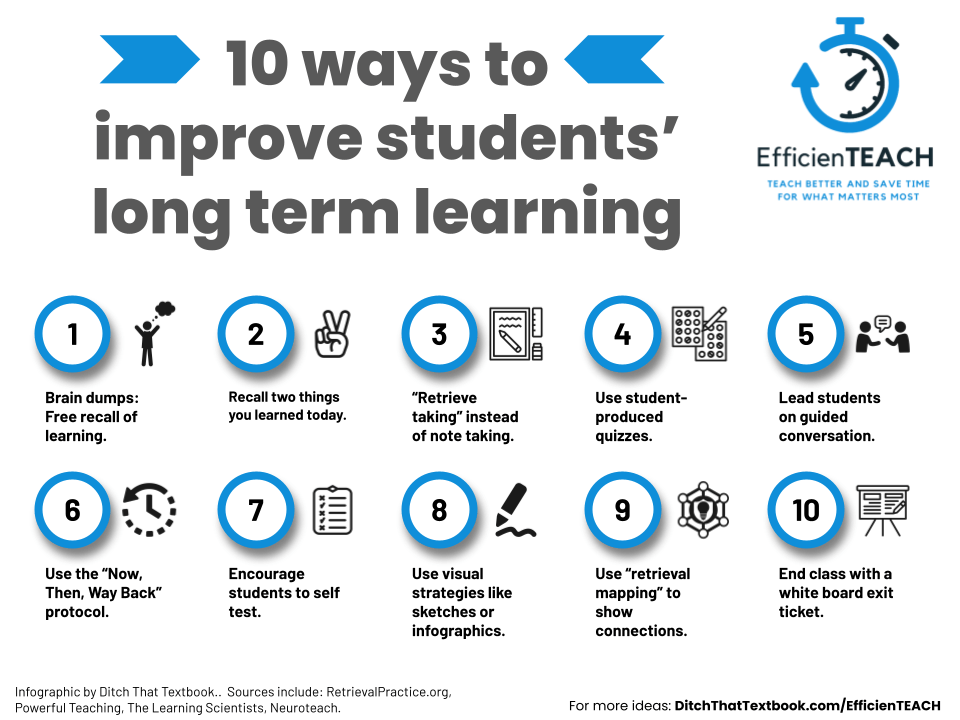

1. Brain dumps
The idea here is simple: get everything you've learned out of your brain.
Put it on paper. Tell it to a friend. Record it on a video. It's like a dump truck. Tip the bed over and get that stuff out of the truck!
It can be as simple as asking students to write out everything they remember about yesterday's class on a sheet of paper. Or you can do digital brain dumps with Flipgrid, Socrative, and other tools. Check out Sticky learning: Digital brain dumps with Flipgrid and Socrative for more.
Either way, the information is flowing out of the brain, and that's the key.
Here are some templates you can copy and assign to students in Google Classroom or your learning management system (LMS).
- Get the "Jamboard Brain Dump" template
- Get the Brain Dump Google Slides template created by Meredith Akers
- Get the Brain Dump Google Form template created by Debbie Campbell

2. Two things
This one is fantastic for bell ringer activities and exit tickets. From the book Powerful Teaching:
"At any point during a lesson, stop and have students write down Two Things about a specific prompt. For example:
- What are Two Things you learned so far today?
- What are Two things you learned yesterday (or last week)?
- What are two examples from your own life that relate to today's lesson?"
Here's what I love about this strategy. First, it's easy and doable. Anyone can come up with two things. Second, it encourages retrieval and participation. It's something you can do at any point during class.
Here's a template you can copy and assign to students in Google Classroom or your learning management system (LMS).
- Get the "Two Things" TODAY template (Google Slides) (PowerPoint)
- Get the "Two Things" YESTERDAY/LAST WEEK template (Google Slides) (PowerPoint)
- Get the "Two Things" OWN LIFE template (Google Slides) (PowerPoint)
- Get ALL THREE "Two Things" templates in the same slide deck (Google Slides) (PowerPoint)
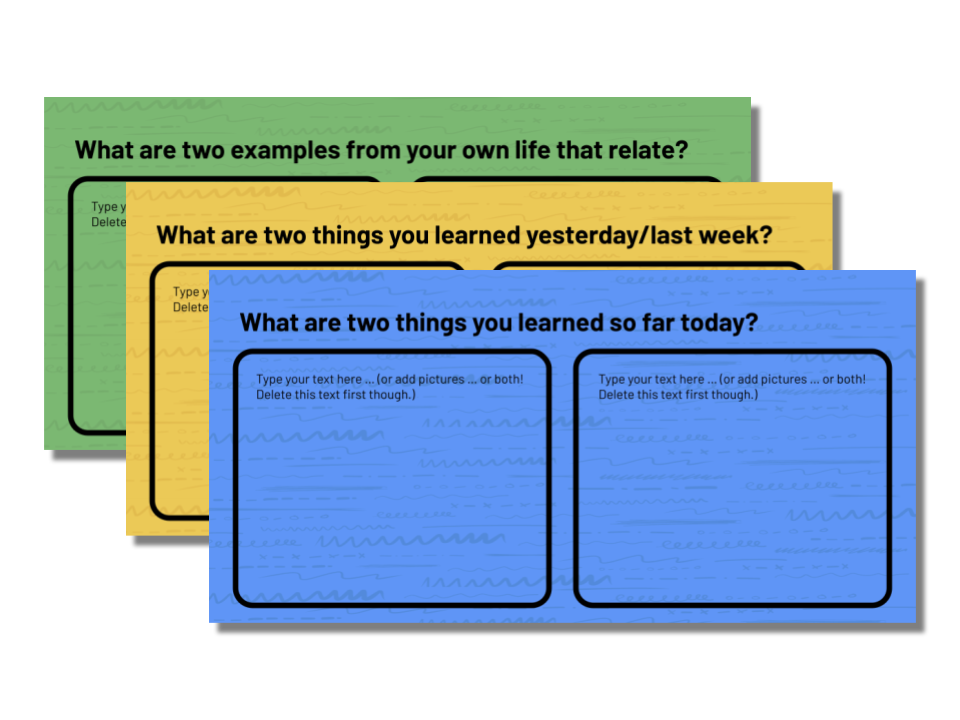

3. Retrieve taking (instead of note taking)
When students take notes, they split their attention. They're trying to pay attention to what they're learning. But they're also trying to catalog it in their notes.
That's a lot to do at once. A small shift can help them focus and encourage them to retrieve, boosting their long-term learning.
Powerful Teaching co-author Patrice Bain uses the "retrieve taking" strategy:
- Teach. Students don't take notes (yet!).
- Pause to let students write down important details.
- Review important topics and facilitate discussion.
- Continue teaching.
Students stop being transcriptionists, writing down every word the teacher says. Instead, they recall what they've learned from their own memories. Plus, because there's a quick teacher-led review, they won't miss anything important.
You can read an article about retrieve taking on the RetrievalPractice.org website or view and download a FREE PDF guide on using retrieval practice to improve learning here.

4. Student-produced quizzes
After learning, students come up with one question that could be asked on a quiz.
Collect the questions and use them to help students retrieve and review.
Here's what I love about this. For one, it puts students in the quiz creator's seat. It's a different perspective that helps them understand the whole process better. Second, it's not something imposed on them by a teacher. They're the ones making the questions.
Also: you don't have to grade these quizzes. One more time: you DON'T have to grade them! Again, remember, low-stakes leads to long-term memory. It's a learning strategy, not an assessment.
Here's a fun, techy way to make these quizzes: Collect student questions in a Google Form and import them into a Quizizz game. Here's how:
- Create a Google Form with the following questions: Question (short answer), Option 1 (short answer), Option 2 (short answer), Option 3 (short answer), Option 4 (short answer), Option 5 (short answer), Correct Answer (multiple choice: 1, 2, 3, 4, 5), Time (number of seconds) or make a copy of this template.
- Share a link to fill out the form with your students. They type their question and possible answers, identify the correct answer, and choose how much time.
- When they're done, download the responses spreadsheet as an Excel spreadsheet.
- Go to Quizizz (quizizz.com) and create a new quiz. Choose the "Import from spreadsheet" option to pull in your students' questions.
- Complete your quiz and share a link with students so they can take it!

5. Guided conversation
This one is simple and is focused on asking students great questions (via Powerful Teaching).
Come up with a series of questions that guides students on a discussion about your content. Example:
- What are four details about our topic yesterday that stuck with you most?
- Do you think it's right to (insert topic of discussion)?
- What are three reasons that support your belief?
Provide these questions on a document (paper, digital, etc.). You could put each question on a slide in Google Slides or PowerPoint and students could answer on their own copies of the slide presentation.
Afterward, students get in small groups to discuss their answers.
It gives students a chance to think quietly, to compose their answers, and then to share them and discuss with others. And you, the teacher, guide the discussion through your prompts.
Here's a VERY SIMPLE template you can copy and assign to students in Google Classroom or your learning management system (LMS). Just make a copy and type the questions you'd ask your students in order into the title section of each slide. Then assign, making a copy for each student.
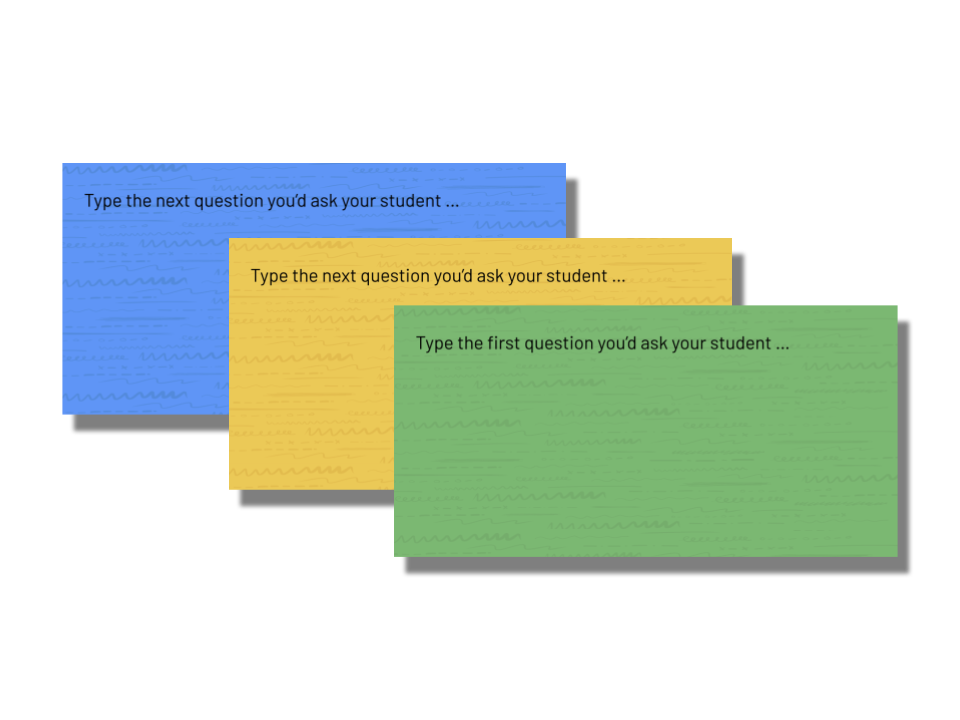

6. Now, then, and way back
You can use this simple protocol as a bell ringer or exit ticket. It has three admittedly vague parts:
- Now: Something they've learned recently
- Then: Something they learned not too long ago
- Way Back: Something they learned a while ago
The teacher can choose the topics, or the students can. The topics can all be related to something students are learning right now, or they can be completely separate. Students recall three things in each category.
Here's a template you can copy and assign to students in Google Classroom or your learning management system (LMS).
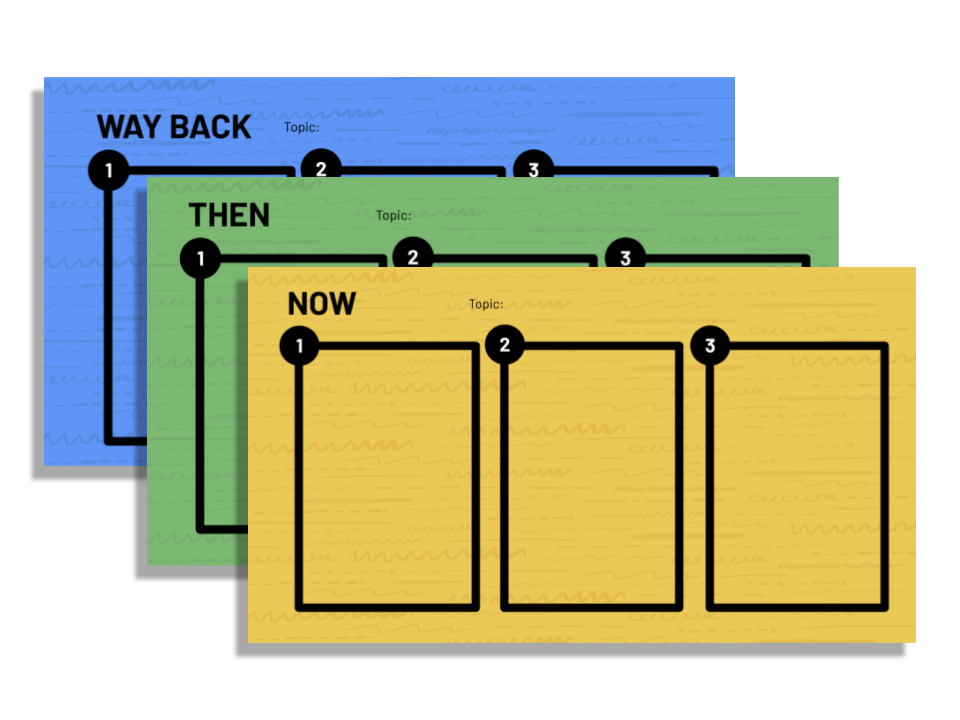

7. Self testing
This strategy was called "one of the most powerful strategies in this chapter" in a chapter called "Memory + Attention + Engagement = Learning" in the book Neuroteach.
Students are used to teachers asking them to take quizzes and tests. We use them as assessments to gauge their learning.
What if students took control? Simple self-testing helps students retrieve learning out of their long-term memory. It can look like this:
- Writing everything you remember on a blank sheet of paper
- Practicing with flash cards
- Telling someone what you've learned
- Attempting review questions
Making students testers of their own learning BEFORE an assigned quiz or test can have great results.
Quizlet flashcards can be a great way to do self-testing ... and a Quizlet Live game is a fun way to get practice! Check out these 6 new ways to play a Quizlet Live game (featuring educational technology coach Patrick McMillan).

8. Recall information visually
Recalling information visually is something The Learning Scientists call back to several times in their retrieval practice guide. They suggest sketching ideas and also identifying how things are related or different from one another.
Sketchnoting (aka "visual notetaking") and infographics are a great way to do this. Plus, they're very brain friendly. According to The Learning Scientists:
Dual coding is combining words and visuals such as pictures, diagrams, graphic organizers, and so on. The idea is to provide two different representations of the information, both visual and verbal, to help students understand the information better.
Sketchnoting can be really simple: a simple sentence or idea paired with a simple doodle to illustrate it. Here are the session resources whenever I present on sketchnoting to educators.
Infographics often use icons and other illustrations paired with text. They're pretty easy to create, and you can start with one of my templates. Here are my infographics resources.
Students can do great verbal/visual learning with infographics! Get them started by making a copy of this infographics template.
Get the template for Google Slides / Get the template for PowerPoint

9. Retrieval mapping
You've probably seen word webs, concept maps, semantic mapping ... or whatever term you've used.
Here's how they're traditionally used. You open up your textbook or notes. You make some bubbles with words in them. Then, you extend the web out, connecting other bubbles to your main bubbles.
The problem? The book or the notes are right in front of us. We don't have to recall information from our brains.
That's why they suggest retrieval mapping instead. Students create these maps from memory instead of from a book or notes. This practice doesn't perform better than just writing down everything you remember, but for students who like concept mapping, it could be a nice alternative.
Check out these tools that help to create mind maps:
- bubbl.us (free plan includes 3 mind maps)
- MindMup (limited free plan)
- Jamboard (part of Google Workspace)
- OneNote (part of Microsoft 365)

10. White board exit ticket
With a traditional exit ticket, students answer a few questions -- or free write -- on a sheet of paper and turn it in.
A white board exit ticket is a twist on this idea.
At the end of class, ask students to write the two things they remember best on the white board at the front of your room. (In fact, the "Two Things" prompts above would be great for this activity.)
When they're done, your board will be covered with things students have learned.
It's a microcosm of what students remembered -- and what they didn't. For that reason, it can guide your instruction for the next day. If students didn't write it, you may want to give it some extra attention. If they clearly remembered it, you might not need as much time on it.
I'd adjust instruction only so much based on the results of this activity. It's a good quick retrieval opportunity. However, if students only write the last thing you said (recency effect), it may skew what they actually remember.
Looking for an online whiteboard to do this activity digitally? Check out these 15 online whiteboard options.

For notifications of new Ditch That Textbook content and helpful links:
Are you looking for quality, meaningful professional learning that both equips and inspires teachers?
Matt provides in-person and virtual keynotes, workshops and breakout sessions that equip, inspire and encourage teachers to create change in their classrooms. Teachers leave with loads of resources. They participate. They laugh. They see tech use and teaching in a new light. Click the link below to contact us and learn how you can bring Matt to your school or district!
Is Matt presenting near you soon? Check out his upcoming live events!

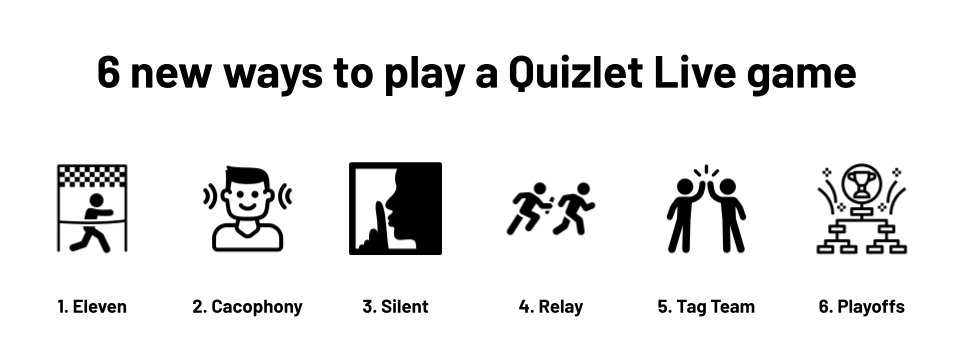


I read your material religiously. I would, however, like to offer one suggestion, and it has nothing to do with content. I would suppose that I am not the only teacher here who is on the upper end of my career, with eyesight that matches my age and experience. The fine lined gray toned fonts used in your newsletters are very hard to read, especially when on a colored back ground. Just something to consider. Thanks for all the wonderful things you share!
Really very happy to say, your post is very interesting to read.
This is a great list of ways to help kids reflect on their learning. I always have students respond in a portfolio paragraph at the end of the day to think about what we did and why, but these would be some great ways to mix it up.
Great ideas on helping students in class
Matt, thank you! You are great!!!